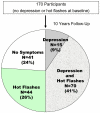Temporal associations of hot flashes and depression in the transition to menopause
- PMID: 19188849
- PMCID: PMC2860597
- DOI: 10.1097/gme.0b013e3181967e16
Temporal associations of hot flashes and depression in the transition to menopause
Abstract
Objective: The aim of this study was to evaluate associations between hot flashes and depressed mood in the menopausal transition and associations of these symptoms with reproductive hormone changes.
Methods: A 10-year follow-up in a population-based cohort of women who had no experience of hot flashes or depressed mood at baseline was conducted.
Results: The incidence of hot flashes significantly increased compared with the incidence of depressed mood in the 10-year follow-up (P < 0.001). Sixty-seven percent of the women reported hot flashes, 50% reported depressed mood, and 41% reported both symptoms during the study interval. Reporting of both hot flashes and depressed mood was greater than expected if the processes operated independently (P < 0.001). Of the women who experienced both symptoms, depressed mood was more likely to precede hot flashes (relative risk = 2.1; 95% CI, 1.5-2.9). Within-woman increases in follicle-stimulating hormone levels were associated with the onset of depressed mood in unadjusted analysis (P = 0.05). Increased follicle-stimulating hormone levels, decreased inhibin B levels, and the variability of estradiol were significantly associated with hot flashes. Follicle-stimulating hormone and inhibin B remained significantly associated with hot flashes in the final multivariable models (P < 0.001).
Conclusions: Both hot flashes and depressive symptoms occur early in the menopausal transition in women with no previous experience of these symptoms. Depressive symptoms are more likely to precede hot flashes in women who report both symptoms. The findings support the concept that the changing hormonal milieu of the menopausal transition is one of multiple factors associated with the onset of symptoms.
Figures
Similar articles
-
Associations of hormones and menopausal status with depressed mood in women with no history of depression.Arch Gen Psychiatry. 2006 Apr;63(4):375-82. doi: 10.1001/archpsyc.63.4.375. Arch Gen Psychiatry. 2006. PMID: 16585466
-
Associations of depression with the transition to menopause.Menopause. 2010 Jul;17(4):823-7. doi: 10.1097/gme.0b013e3181db9f8b. Menopause. 2010. PMID: 20531231 Review.
-
Insomnia in women approaching menopause: Beyond perception.Psychoneuroendocrinology. 2015 Oct;60:96-104. doi: 10.1016/j.psyneuen.2015.06.005. Epub 2015 Jun 17. Psychoneuroendocrinology. 2015. PMID: 26142241 Free PMC article.
-
Hot flashes in the late reproductive years: risk factors for Africa American and Caucasian women.J Womens Health Gend Based Med. 2001 Jan-Feb;10(1):67-76. doi: 10.1089/152460901750067133. J Womens Health Gend Based Med. 2001. PMID: 11224946
-
Depression in the menopause transition: risks in the changing hormone milieu as observed in the general population.Womens Midlife Health. 2015 Aug 11;1:2. doi: 10.1186/s40695-015-0002-y. eCollection 2015. Womens Midlife Health. 2015. PMID: 30766689 Free PMC article. Review.
Cited by
-
Nocturnal Hot Flashes, but Not Serum Hormone Concentrations, as a Predictor of Insomnia in Menopausal Women: Results from the Midlife Women's Health Study.J Womens Health (Larchmt). 2023 Jan;32(1):94-101. doi: 10.1089/jwh.2021.0502. Epub 2022 Nov 25. J Womens Health (Larchmt). 2023. PMID: 36450126 Free PMC article.
-
Factors associated with the high susceptibility to depression of women during the perimenopause.Brain Behav. 2023 Jan;13(1):e2826. doi: 10.1002/brb3.2826. Epub 2022 Dec 8. Brain Behav. 2023. PMID: 36479809 Free PMC article.
-
Negative affect and vasomotor symptoms in the Study of Women's Health Across the Nation Daily Hormone Study.Menopause. 2011 Dec;18(12):1270-7. doi: 10.1097/gme.0b013e3182230e42. Menopause. 2011. PMID: 21900850 Free PMC article.
-
Metabolic activity in the insular cortex and hypothalamus predicts hot flashes: an FDG-PET study.J Clin Endocrinol Metab. 2012 Sep;97(9):3207-15. doi: 10.1210/jc.2012-1413. Epub 2012 Jun 20. J Clin Endocrinol Metab. 2012. PMID: 22723326 Free PMC article.
-
The role of cytokines and hot flashes in perimenopausal depression.Ann Gen Psychiatry. 2012 Apr 10;11:9. doi: 10.1186/1744-859X-11-9. Ann Gen Psychiatry. 2012. PMID: 22490187 Free PMC article.
References
-
- Freeman EW, Sammel MD, Lin H, et al. Symptoms associated with menopausal transition and reproductive hormones in midlife women. Obstet Gynecol. 2007;110:230–240. - PubMed
-
- Alexander JL, Dennerstein L, Woods NF, et al. Neurobehavioral impact of menopause on mood. Expert Rev Neurother. 2007;7:S81–S91. - PubMed
-
- Kravitz HM, Ganz PA, Bromberger J, Powell LH, Sutton-Tyrrell K, Meyer PM. Sleep difficulty in women at midlife: a community survey of sleep and the menopausal transition. Menopause. 2003;10:19–28. - PubMed
-
- Whiteman MK, Staropoli CA, Benedict JC, Borgeest C, Flaws JA. Risk factors for hot flashes in midlife women. J Womens Health. 2003;12:459–472. - PubMed
Publication types
MeSH terms
Substances
Grants and funding
LinkOut - more resources
Full Text Sources
Medical


